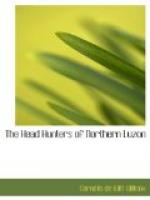In some respects these Kalingas differed from the tribes already visited. Their superior height has already been noted. It may be noted further that they are sloe-eyed, and their eyes are wide apart. It is said that they have an infusion of Moro blood, brought in, many years ago, by exiles from Moroland turned loose on the north coast of Luzon by the Spaniards, with the expectation that the local tribes would kill them; instead, they intermarried. Among themselves they call their important men dato, a Moro title, and their Moro dress has already been mentioned. They will not marry outside of their own blood, and their women, so we were told, would not look at a white man.
Lubuagan itself is extremely well situated on a gigantic terrace-like slope, as though, as at Kiangan, an avalanche of earth had burst through the rim of encompassing mountains. Here live the Governor of the province and the inspector of Constabulary with a detachment; their houses, with the cuartel and public offices, are disposed around a sort of parade, divided into an upper and a lower terrace. Aguinaldo marched through the place during his flight, and left behind seventeen of his men, sick and wounded. He had no sooner gone than these were all taken out and beheaded. The native town lies above and just back of the parade, with its houses running well up on the slopes. These are, everywhere possible, terraced for rice, and so successfully that two crops are made every year, as against only one at Bontok and elsewhere. It follows that the Kalingas have more to eat than their relatives to the south, and that is perhaps one reason of their greater stature.
The morning of the 12th, our one full day at Lubuagan, broke clear, bright, and hot, and so the day remained. Events during the next few hours had no particular axis. We looked on mostly, though, of course, here as elsewhere, business there was to be dispatched. The upper terrace was the scene of crowded activity, being packed with people from sunrise to sunset. Dancing went on the whole day; the sound of the gansa never ceased. A particularly interesting dance was that of a number of little girls, eight or ten years of age, who went through their steps with the greatest seriousness and dignity, a very pretty sight. In yet another the performers, nine all told, grown men, attracted attention from the fact that the handles of their gansas were human lower jaws, apparently new, in the teeth of two of which gold fillings glistened. The Ifugaos, who, it will be recollected, had accompanied us from Banawe, also danced, their steps, motions, and music forming a sharp contrast. This dance over, Comhit could not restrain himself, but made a speech, in which he declared that “These people up here, the Kalingas, are very good people indeed, but not so good as the Ifugaos.” Fortunately, only his own people understood him. He had noticed on the way that the people we passed offered nothing




